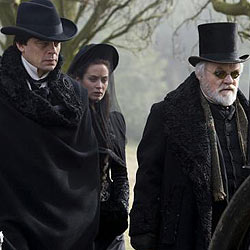Venus In Fur: Femininity, Masculinity, And The Wolfman
Published on March 10th, 2010 in: Current Faves, Feminism, Horror, Movie Reviews, Movies, Reviews, Teh Sex |By Hanna

When The Wolfman‘s release date was announced, feminist blog Jezebel asked why there aren’t many female werewolves, concluding that because werewolves are disgusting and hairy, people don’t want to equate that with women. They also pointed out that vampires are a lot more popular than werewolves at the moment, and described that position with regards to sex.
Although the answer to the question about women and werewolves lies exactly in those issues, Jezebel drew the wrong conclusions.
All monsters, and indeed most Gothic stories, are about sex in some measure, but there are differences in every story as well as the tendency to portray a certain monster a certain way.
Generally, in criticism about the Gothic, vampires are equated with consensual sex. The pinnacle of the vampirism-as-sex metaphor is, of course, the Twilight series.
Werewolves, on the other hand, are usually interpreted as a metaphor for domestic violence and abuse, especially child abuse. A good example of the werewolf being used in this way are the Harry Potter characters Fenrir Greyback, who loves eating children, and, Remus Lupin, who though generally a benign teacher, is a hidden threat to the children in the school and accidentally almost kills Harry and his friends.
Werewolves are more concerned with violence against children than threats against vampires, and because of this abuse connection, women play a minor part. Of course, women are not typically seen as perpetrators of abuse in Western society, so it would make sense that most werewolves are men. There is a story by Dutch children’s author Paul van Loon featuring a female werewolf who is also a teacher of primary school boys and thus, fits more neatly into the idea of the teacher as abuser.
Unlike the vampire, the werewolf does not seduce its victims into complying; it simply emerges and destroys. Its only protection is the trust that other people have in its human form. In The Wolfman, they blame gypsies, animals, or madmen. Somehow they do not seem to notice how one person in the story is mysteriously absent once a month, or has injuries similar to that of the werewolf.
This phenomenon, often mocked, is actually the most realistic feature of the entire werewolf mythology. Only madmen, animals, and foreigners rape and abuse children, of course, not great men in society. Like in the Roman Polanski rape case, people in werewolf stories do not see who the culprit is and often do not even view the crimes as they are (the actions of a werewolf) because they do not want to.
The Wolfman is a good film for people unacquainted with basic werewolf symbolism, as it takes the symbolism and beats the audience over the head with it.
Though the Wolfman of the title is the main character, Lawrence Talbot, it is his father, who though initially merely emotionally distant, turns out to be the more destructive werewolf, and one whom actively takes pleasure in the curse. John Talbot enjoys killing; he relishes in biting Lawrence and seeing him turn out slowly like him. The quiet joy with which Anthony Hopkins beats up his son during their final fight is one of the few scenes in the film that purveys a true horror, deeper than the tropes of heads on sticks and entrails on the floor, which the rest of the film focuses on.

Struggling to not become like his father, Lawrence accidentally chooses actions that will make him more like him: chasing after the werewolf gets him bitten; being committed to a madhouse to be cured provokes his rampage around London; and instead of killing his father with a silver bullet he needs to become a werewolf and fight him in that form.
At times, the film reminded me of Michael Jackson, who also famously became a werewolf in the “Thriller” video; Sheila Whitely, in her book Too Much, Too Young (about gender, age, and pop music) compared Jackson to a werewolf—a self-made one—who transformed to get away from the image of the abusive father.
However, like with the abuse angle, instead of showing or deepening the psychology, the director of The Wolfman decided to focus on the short-term impact, using the prolonged werewolf fight between the father and son as metaphor for the inner struggle. The mental institution Lawrence’s father commits him to becomes shorthand for mental torment when the visual language of transformation might have been more effective. The Wolfman does use transformation imagery, which although effective in its depiction of pain, doesn’t really go beyond that.
As for The Wolfman in 2010 being a remake of the 1941 film: there isn’t any real resemblance between the two films except the now iconic werewolf make-up. The 1941 film focused on Lawrence’s class privilege and sex drive, and proceeded to punish him for that. He became a werewolf by killing a gypsy, and for lusting after women. His father, however, metes out the punishment, and so some degree of the authority abuse angle was already there.
With the old fashioned, almost campy aesthetic, garish use of color and costume, and the melodrama of both the storyline as well as the brooding, Byronic acting style of Del Toro, The Wolfman wasn’t destined to be a film that seems “good” to modern audiences, when everything is recorded with high contrast and a black filter, where every storyline is gritty and violence is realistic.
The reluctance to choose between a psychological storyline focusing on the symbolism of the werewolf myth and a campy, gory bloodfest makes The Wolfman a dubious contender for cult status, but as a development of the werewolf mythology it is nearly perfect.
Now that we have reached a stage, after Michael Jackson’s death and after countless church scandals, where domestic and sexual abuse have become slightly more discussable, these issues have reclaimed their place in the werewolf saga. If society gets even more progressive, quite soon there might be a real female werewolf like the kind Jezebel wants.
Time limit is exhausted. Please reload the CAPTCHA.